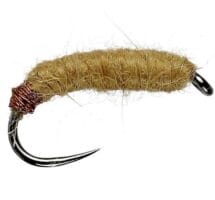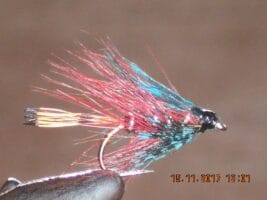Your cart is currently empty!
Sawyer Killer Bug Fly
The Sawyer Killer Bug fly stands as one of fly fishing’s most iconic and enduring patterns, developed in the 1930s by legendary river keeper Frank Sawyer on England’s famed River Avon.
Description
Historical Significance and Pattern Evolution
The Sawyer Killer Bug fly stands as one of fly fishing’s most iconic and enduring patterns, developed in the 1930s by legendary river keeper Frank Sawyer on England’s famed River Avon. Originally conceived as the “Grayling Killer Bug,” this pattern emerged from Sawyer’s meticulous observation of aquatic life and his innovative approach to fly construction. What sets this pattern apart is its unique construction method using copper wire instead of traditional tying thread, a revolutionary technique for its time that continues to influence fly tying today.
The pattern’s historical significance extends beyond its innovative construction. Sawyer’s creation represented a departure from the ornate, traditional patterns of the era, demonstrating that effective flies could be simple and practical. The original pattern utilized Chadwick’s 477 wool, a specific shade that proved incredibly effective but is no longer available, leading to modern adaptations that maintain the pattern’s effectiveness while using contemporary materials.
Material Science and Performance Enhancement
Premium Component Integration:
- Chemically sharpened curved hooks (sizes 10-14) for optimal penetration
- Specialized copper wire in specific reddish-brown shade for segmentation
- Original Chadwick’s 477 wool or modern equivalents (Jamieson’s Shetland Spindrift)
- Optional lead underbody for enhanced sink rate in deeper waters
- Precise proportioning techniques for natural presentation
- Advanced dubbing methods for proper profile
- Color-matched materials for maximum effectiveness
- Size-specific components for different water conditions
- Enhanced durability features through wire construction
- Strategic wire placement for proper weight distribution
Construction Methodology and Technical Specifications
Wire-Based Engineering:
- Specialized copper wire wrapping techniques creating natural segmentation
- Calculated body proportions matching various aquatic larvae
- Precise wire spacing for durability and weight distribution
- Engineered taper profiles mimicking natural prey
- Strategic weight placement for optimal drift
- Balanced material density throughout the pattern
- Controlled buoyancy characteristics in different water columns
- Enhanced strike-triggering features through proper proportioning
- Optimized hook penetration angles
- Size-matched components across pattern ranges
Advanced Construction Techniques:
- No-thread tying methodology
- Specialized dubbing application
- Wire tension control systems
- Body segmentation protocols
- Profile maintenance procedures
- Weight distribution calculations
- Material density control
- Taper formation methods
- Hook gap maintenance
- Pattern durability enhancement
Water Column Tactics and Presentation Methods
Deep Water Applications:
- Precision depth control through weight adjustment
- Current velocity compensation techniques
- Structure approach protocols for various obstacles
- Depth maintenance systems in strong currents
- Strike indication enhancement methods
- Pattern movement variations for different species
- Recovery position optimization strategies
- Multiple rig configurations for varying conditions
- Line control refinement techniques
- Drift speed management protocols
Mid-Column Presentations:
- Suspended drift techniques for neutral buoyancy
- Current break exploitation strategies
- Edge water approach methodologies
- Visual strike detection systems
Advanced Seasonal Applications
Winter Deployment:
- Deep pool targeting strategies
- Slow presentation methodologies
- Temperature-based approach modifications
- Light condition adaptations
- Leader system modifications
Spring Tactics:
- Temperature transition strategies
- Hatch matching protocols
- Water clarity adaptations
- Light penetration compensation
- Oxygen level assessment
- Feeding behavior matching
- Pattern rotation strategies
- Presentation speed adjustment
- Structure approach variations
- Multiple pattern approaches
Summer Applications:
- Early morning presentation techniques
- Evening feeding period strategies
- Deep water approaches
- Fast current tactics
- Temperature considerations
- Light penetration factors
- Oxygen level assessment
- Feeding behavior matching
- Pattern rotation protocols
- Presentation speed adjustment
Fall Strategies:
- Pre-winter feeding period tactics
- Water temperature adaptation
- Light condition considerations
- Pattern size modifications
- Color selection refinement
Technical Water Applications
Chalk Stream Specifics:
- Clear water presentation methods
- Selective fish approach tactics
- Micro-current reading techniques
- Pattern size reduction protocols
- Leader length optimization
- Tippet diameter selection
- Strike detection refinement
- Recovery position selection
- Follow-through protocols
- Multiple rig considerations
Freestone River Tactics:
- Pocket water presentation methods
- Boulder field navigation strategies
- Current seam exploitation
- Structure targeting protocols
- Depth variation strategies
- Pattern size adaptation
- Color selection criteria
- Retrieve speed adjustment
- Strike zone identification
- Recovery position optimization
Spring Creek Applications:
- Sight fishing methodologies
- Stealth presentation techniques
- Current seam exploitation
- Structure targeting protocols
- Depth variation strategies
- Pattern size adaptation
- Color selection criteria
- Retrieve speed adjustment
- Strike zone identification
- Recovery position optimization
Environmental Adaptation Methods
High Water Conditions:
- Weight adjustment techniques
- Pattern size modification
- Color selection refinement
- Presentation speed adaptation
- Depth control methods
- Structure approach strategies
- Safety consideration protocols
- Recovery technique modification
- Pattern rotation strategies
- Leader system adaptation
Low Light Operations:
- Enhanced visibility patterns
- Flash material integration
- Contrast enhancement methods
- Presentation modifications
- Depth adjustment protocols
- Strike detection systems
- Pattern size optimization
- Color brightness adaptation
- Recovery position modification
- Multiple pattern approaches
Clear Water Tactics:
- Fine tippet selection
- Precise presentation methods
Advanced Rigging Specifications
Leader Engineering:
- Extended leader systems
- Specialized tippet selection
- Strategic material placement
- Weight distribution calculations
Terminal Tackle Configuration:
- Direct tie methods
- Dropper spacing calculations
- Pattern combination selection
- Weight placement strategies
The Sawyer Killer Bug represents a masterpiece of simplicity in fly design, proving that effective patterns don’t necessarily require complex materials or techniques. Its enduring success across decades of use testifies to Frank Sawyer’s genius in observation and pattern development. Whether fished in its original form or modern adaptations, this pattern continues to produce exceptional results across varying conditions and species.
Additional information
| Hook size | 10, 12, 14, 16, 18, 20 |
|---|---|
| Hook type | Barbed Hooks, Barbless Hooks |







